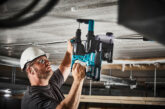
Simon Johnson of EnOcean argues the case for grown-up wireless technology.
Wireless technology is finding its way into every aspect of our homes, offices, bars and restaurants, controlling not just the “smart” lighting but now HVAC, shading, environmental monitoring, FM solutions, room occupancy and assisted living solutions. It offers a whole new approach to smart control, and because it often does away with the need to chase in new wires and making good, it’s an easier install and an easier sell to homeowners.
Is it reliable enough for you to put your reputation behind it? The answer is a resounding yes – as long as you do your market research. Like so many aspects of technology, wireless has evolved exponentially. We all rely on phones and tablets that communicate wirelessly, and most homes now use wireless internet rather than the Ethernet routers and cables that were commonplace just a few years ago. You are unlikely to experience customer objections to wireless technology. So, which applications will you use it for? Which products? Which brands?
The reliable choice
We all remember the first wireless products aimed at the domestic market and how flaky they were – but the technology has moved on for professional installers. Emerging as the safe, flexible and reliable choice is EnOcean wireless technology. Used primarily in smart homes and building automation systems it is (like other leading approaches to smart control, such as DALI for lighting and KNX for high-end projects) an open protocol. In other words, it’s not owned or controlled by a single manufacturer. In fact, there are about 400 firms making EnOcean complaint devices. Currently, the biggest of these, with the widest range and market share and the support network that goes with market leadership, is Eltako, a German firm that is establishing a bigger presence in the UK wholesale market, from simple light switches to whole-home and building controllers.
The EnOcean technology is energy harvesting, which means switches that communicate with remote hard-wired relays and actuators do not need batteries. It is based on harvesting slight mechanical motion (such as flicking a switch) or other potentials from the environment, such as indoor light and temperature differences. Energy harvesters provide only a very small amount of power, but it’s quite enough for sensors and switches to communicate wirelessly with the relays, gateways and controllers that turn on/off and adjust lighting, heating and electrical appliances.
No wires or batteries – maintenance free
EnOcean-based devices use ultra-low power electronics to perform without batteries and, with no wires and no batteries, are engineered to operate maintenance-free. The radio signals from sensors and switches can be transmitted wirelessly over a distance of up to 300 meters in the open and up to 30 meters inside buildings, giving you huge scope to provide your customers with control where it is needed.
A popular entry level EnOcean installation is a light switch and dimmer where the switch plate is simply affixed to the wall in the most convenient place and the actuator might be just connected to the light and popped through the ceiling aperture, or behind an existing switch plate. In my experience, once they’ve tried this, installers are hooked and want to know more about possibilities to scale this up to a complete smart solution with an APP and voice control.
After all, consumer expectation is high. It’s not enough just to supply a couple of sockets and switches or a thermostat. A smart property requires more, probably at the very least lighting dimming and scenes, reliable and accurate temperature control, PIRs to monitor presence and turn lights on automatically, some security alarms or control, and probably much more. It’s also increasingly assumed that this can all be integrated and controlled on a phone or tablet. EnOcean’s wireless standard has it all covered and it’s coming to a wholesaler near you.
View the EnOcean product selection guide to find out which products are suited to you.








